A Comprehensive Guide to Bearded Dragons
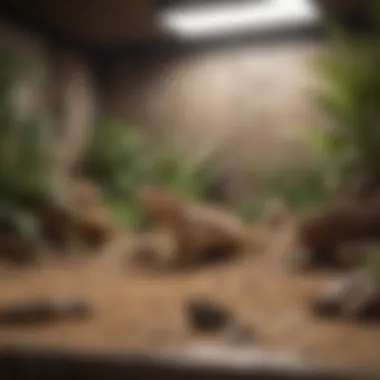

Intro
Bearded dragons have become popular pets in recent years due to their manageable size and unique personalities. For beginners, there is much to understand before bringing one home. This guide aims to provide a thorough understanding of the essential aspects of caring for bearded dragons. By breaking down topics such as care tips, behavioral insights, nutrition, wellness, and ways to enrich their environment, prospective owners can make informed decisions to ensure the well-being of their new pet.
Understanding the needs of bearded dragons is crucial—from habitat setup to nutrition, every element contributes to creating a supportive environment. This article will help new enthusiasts learn what it takes to provide for these reptiles responsibly.
Care Tips
Daily care routines are essential for maintaining a healthy bearded dragon. These routines should include monitoring their temperature, humidity, and cleanliness. The enclosure must be spacious enough to allow for movement, and various hiding spots should be provided to reduce stress.
Daily Care Routines
Conduct daily checks on your bearded dragon's health. Observing their behavior will help detect any irregularities early. Daily feeding and hydration are important. Ensure fresh water is always available.
Cage Setup and Maintenance
Setting up the cage properly is key to a happy pet. A suitable enclosure should be at least 40 gallons for an adult, with a basking area between 95°F and 110°F. Use a reliable substrate like reptile carpet to maintain cleanliness and ease of cleaning. Regularly change food and water bowls, and monitor temperatures.
Hygiene and Cleaning Practices
Cleaning practices must include removing uneaten food daily and spot cleaning waste. A full clean of the enclosure should happen weekly. Use reptile-safe disinfectants to ensure the environment remains healthy for your pet.
Seasonal Care Adjustments
Bearded dragons require adjustments in care based on the seasons. In colder months, they need increased basking time and a closer watch on their heating systems. Understanding these seasonal changes will assist in preventing any health issues.
Behavioral Insights
Understanding your bearded dragon's body language is vital. Bearded dragons communicate through various gestures and movements.
Understanding Bearded Dragon Body Language
A waving hand could indicate submission, while a puffed beard signals aggression or discomfort. Recognizing these cues helps in providing a supportive atmosphere.
Common Behavioral Issues and Solutions
Common issues include stress from improper habitat conditions or insufficient social interaction. If you notice your dragon hiding excessively or displaying aggression, a review of the habitat and daily interactions may help identify underlying problems.
Positive Reinforcement Techniques
Bearded dragons respond well to positive reinforcement. Offering treats or praise for desired behaviors can encourage interaction and foster a bond with your pet.
Social Interaction Needs
Bearded dragons are generally solitary animals, but social interaction is still important. Engage with your pet regularly, offering gentle handling and observation, thereby building trust.
Nutrition Guides
Proper nutrition is fundamental to the health of bearded dragons. Understanding their dietary needs should be a priority.
Essential Diet Components
A balanced diet includes vegetables, fruits, and insects. Dark leafy greens should form a large portion of their diet. Foods like collard greens, dandelion greens, and squash are excellent choices.
Safe and Toxic Foods
Not all vegetables and insects are safe. Foods like iceberg lettuce and avocado are toxic. Familiarize yourself with what is safe to feed.
Supplements and Treats
Certain vitamins and minerals are essential. Use calcium supplements to aid in bone health. Occasional treats like fruit should be given sparingly but can be nutritious.
Feeding Strategies for Different Species
Consider age and species when determining feeding strategies. Juvenile bearded dragons consume more protein than adults. Adjust the feeding frequency based on their growth stage.
Wellness and Health
Monitoring the health of your bearded dragon is important. Regular checkups will assist in maintaining optimal health.
Routine Health Checkups
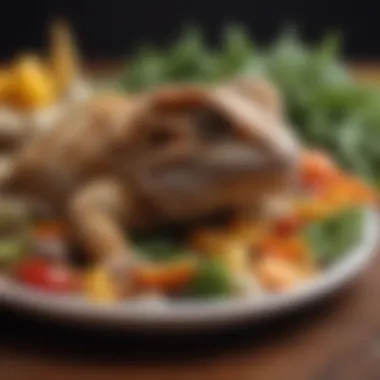
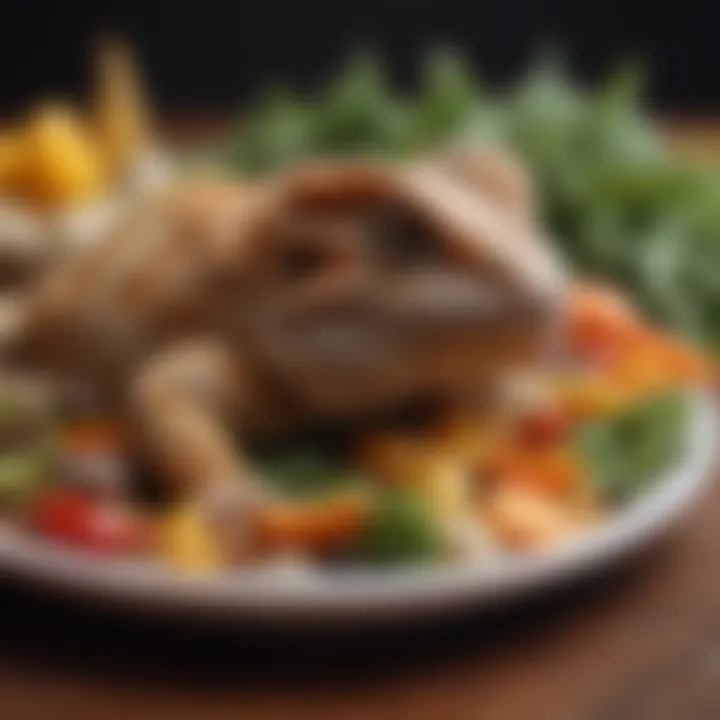
Taking your bearded dragon for annual checkups can help catch any potential health issues early. A qualified vet familiar with reptiles is ideal.
Identifying Symptoms of Illness
Watch for signs such as lethargy, poor appetite, or abnormal droppings. These symptoms can indicate underlying health problems.
Preventative Care and Vaccinations
Routine care includes keeping the environment clean and providing proper nutrition. Vaccination is typically not needed, but regular checkups will help you stay informed about your pet's health status.
Mental and Emotional Well-being
Providing an enriching environment is crucial for mental health. Interactive elements in their habitat can prevent boredom and promote well-being.
Enriching Activities
Creating stimulating environments keeps bearded dragons engaged. Simple activities can enhance their quality of life.
Toys and Playtime Ideas
Introducing toys specific for reptiles can be beneficial. Items like climbing logs can encourage exercise and exploration.
Training and Tricks
Many bearded dragons can learn simple tricks through repeated actions. Using treats or positive reinforcement can motivate them during training sessions.
Outdoor Activities and Interaction
Supervised outdoor time can be stimulating and enjoyable. Ensure a safe, enclosed area to prevent escape.
DIY Projects for Mental Stimulation
Consider building DIY projects that promote exploration, such as tunnels or climbing structures, for enhancing their living area.
By understanding the unique needs and behaviors of bearded dragons, owners can create a thriving environment. This guide serves as a resource to navigate the many facets of caring for these fascinating reptiles.
Prelude to Bearded Dragons
This section sets the foundation for understanding bearded dragons and their place in the world as pets. It is essential for beginners to grasp the significance of this reptile's characteristics, needs, and behaviors before making a commitment to care for one. Knowledge of the species will encourage informed decisions, leading to a healthy and enriching experience for both the pet and the owner.
Understanding the Species
Bearded dragons, native to Australia, belong to the family Agamidae. These reptiles have a calm temperament and exhibit a variety of colors and patterns, making them appealing companions. They can grow up to 24 inches long, with males typically larger than females. In their natural habitat, they are often found basking on rocks, absorbing sunlight to regulate their body temperature. This species is known for its distinctive appearance, particularly the beard-like pouch that can inflate when they feel threatened or stressed.
Understanding their natural behaviors is fundamental for proper care. They are diurnal creatures, active during the day, which aligns well with human schedules. Bearded dragons are also omnivores, feeding on a mix of plants and insects, which adds diversity to their diet. Recognizing these traits will help new owners create an environment that caters to the bearded dragon’s needs.
Why Choose a Bearded Dragon?
Choosing a bearded dragon as a pet comes with numerous benefits that appeal to both novice and experienced pet owners. Here are some reasons why bearded dragons are a good choice:
- Gentle Nature: They tend to be less aggressive than other reptiles, making them suitable for families with children.
- Interactive Pets: Bearded dragons can bond with their owners. They enjoy handling and interaction, which can enhance the owner-pet relationship.
- Low Maintenance: Compared to some other reptiles, bearded dragons have relatively simple care requirements. With the right setup, they thrive well in captivity.
- Educational Value: Owning a bearded dragon provides opportunities for learning about animal care, biology, and the environment. This can be an enriching experience for families.
Essential Habitats
Creating a suitable habitat for a bearded dragon is crucial for its well-being. Bearded dragons require a specific environment that reflects their natural habitat to thrive. Understanding the dynamics of their habitat elements is essential for maintaining health and happiness.
Choosing the Right Enclosure
Selecting the proper enclosure can impact many aspects of a bearded dragon's life; a snug yet spacious environment works best. Generally, a glass terrarium is often recommended for visibility and ease of maintenance. The size of the enclosure is important. A 40-gallon tank is usually adequate for younger dragons. For adult bearded dragons, consider a larger setup, perhaps around 75 to 100 gallons. Moreover, ventilation ought to be adequate; this prevents moisture buildup and promotes air circulation. Placing the enclosure in a location away from direct sunlight is crucial. High temperatures from sunlight may overheat the habitat.
Temperature and Lighting Requirements
Temperature regulation is vital, as bearded dragons are ectothermic and rely on their environment to maintain body heat. A gradient is essential—creating a warm side with temperatures between 95°F to 110°F and a cooler side around 75°F to 85°F. It helps them regulate their body temperature effectively. Additionally, providing UVB lighting is critical. Such lighting promotes calcium absorption and prevents metabolic bone disease. A UVB bulb should be placed within the enclosure but not directly under heat lights, as it needs to be accessible while allowing the dragons to find shade. Replacing UVB bulbs every six months is advised, regardless of usage.
Substrate and écor Considerations
Choosing the right substrate is another important aspect of the habitat. Numerous options are available, including reptile carpet, paper towels, or sand. Avoid calcium sand, as it can lead to impaction if ingested. The choice of décor can enhance a dragon's habitat by providing hiding spots and climbing opportunities. Rocks, logs, and artificial plants can create stimulation and comfort. Be cautious that all décor items are safe and free of sharp edges that might injure the dragon. Maintaining a clean environment is paramount; spot cleaning daily and performing thorough cleanings weekly can help prevent bacteria buildup.
"A well-created habitat significantly enhances the quality of life for your bearded dragon and promotes longevity."
By ensuring an appropriate habitat, owners can foster a healthy, active, and contented bearded dragon.


Feeding and Nutrition
Feeding and nutrition are vital components in the overall care of bearded dragons. Proper nutrition directly impacts their health, growth, and behavior. It is essential to provide a balanced diet consisting of various food sources to meet their dietary needs. In this section, we will delve into the specifics of bearded dragons' dietary requirements, suitable food options, and the importance of vitamin and mineral supplementation. This comprehensive guide ensures that owners are equipped to take appropriate measures to promote the health and well-being of their pets.
Understanding Dietary Needs
Bearded dragons are omnivores, which means they consume both plant matter and animal proteins. Their diet must be diverse enough to provide essential nutrients and sustain their health. Understanding these dietary needs begins with recognizing their age and growth stage.
Juvenile dragons require more protein to support their rapid growth, while adults tend to need more plant-based foods as they require lower protein levels. Young bearded dragons should primarily be fed insects like crickets and mealworms. This ensures adequate protein intake. In contrast, adults should consume leafy greens such as collard greens, as well as fruits like strawberries, in moderation.
In terms of quantity, juvenile bearded dragons might need to eat several times a day, while adult dragons can be fed once every few days.
Recommended Food Sources
To support the nutritional needs of bearded dragons, a variety of food sources should be offered:
- Insects: Crickets, mealworms, and superworms are excellent protein sources. Choose appropriately sized insects, especially for small dragons.
- Leafy Greens: Offer kale, collard greens, dandelion greens, and turnip greens regularly. They provide vital vitamins and minerals.
- Fruits: Fruits like apples, berries, and mango can be given as treats. Moderation is key due to the sugar content.
- Commercial Diets: Brands like Repashy and Fluker's provide gel and dry foods specially formulated for bearded dragons.
It's crucial to avoid feeding some items, such as avocado and rhubarb, which are toxic to these reptiles.
Supplementing with Vitamins and Minerals
Bearded dragons can benefit significantly from vitamin and mineral supplementation. As they can be prone to deficiencies, regularly dusting their food with calcium powder, especially during feeding time, is essential. Additionally, providing a multivitamin supplement once or twice a week can prevent various health issues related to nutrient deficiencies.
Consumers should choose high-quality supplements designed specifically for reptiles to ensure proper absorption and efficacy.
"A balanced diet with appropriate supplements is crucial for the health of your bearded dragon."
In summary, understanding the dietary needs of bearded dragons is fundamental to their care. Offering a varied diet of insects, greens, and fruits, along with proper supplementation, lays the foundation for a healthy and thriving pet.
Health and Wellness
The well-being of bearded dragons is one of the critical aspects to ensure they thrive as pets. Understanding health and wellness means familiarizing oneself with common health problems, the importance of regular veterinary visits, and recognizing the signs that indicate a healthy bearded dragon. Each of these areas plays a vital role in the overall care and management of these fascinating reptiles.
Common Health Issues
Bearded dragons can suffer from various health issues. Early detection can significantly improve their outcomes, making it essential for owners to stay vigilant. Some common health concerns to note include:
- Metabolic Bone Disease (MBD): This condition often arises from inadequate exposure to UVB light or calcium deficiency. Symptoms include lethargy, bone deformities, and twitching. If left untreated, it can lead to severe complications.
- Parasites: Internal and external parasites can affect your bearded dragon's health. Symptoms may range from weight loss to unusual fecal consistency. A stool sample analysis by a vet can help detect these pests.
- Respiratory Infections: Signs include wheezing, excessive mucus, or mouth breathing. These infections can stem from poor ventilation or high humidity levels in the habitat, requiring prompt veterinary care.
- Ringworm: A fungal infection that can present as patches of hair loss. Unlike common skin conditions, it is contagious and can spread to humans and other animals.
Routine Vet Check-ups
Regular veterinary check-ups are essential for maintaining your bearded dragon's health and wellness. Just as humans need check-ups, these reptiles require annual evaluations to monitor their health status.
- Prevention and Early Detection: Routine exams allow for the opportunity to catch health problems before they become severe. A vet can perform a complete physical examination.
- Vaccinations and Treatments: Your vet will recommend necessary vaccinations or treatments to safeguard your bearded dragon against diseases.
- Dietary Guidance: During these check-ups, you can also receive tailored advice on your bearded dragon's diet, ensuring they get the right nutrition for their growth and health.
Signs of a Healthy Bearded Dragon
Recognizing the signs of a healthy bearded dragon is crucial for every owner. A healthy dragon will show:
- Active Behavior: They will exhibit normal levels of activity, exploring their environment and interacting curiously with their surroundings.
- Clear Eyes and Skin: Bright, clear eyes and smooth, intact skin signify good health. Any signs of discharge or swelling warrant further inspection.
- Regular Eating Habits: A healthy bearded dragon will eat regularly and maintain a stable weight.
- Proper Temperature Regulation: They should be able to bask under heat sources but will also move to cooler areas in their habitat as needed.
Regular checks and being aware of your bearded dragon's normal behavior can significantly contribute to their longevity and happiness.
Understanding and committing to health and wellness protocols ensure that your bearded dragon can enjoy a full, active life. Each aspect of their well-being interlinks, creating a comprehensive picture of what it means to care effectively for these remarkable reptiles.
Behavioral Insights
Understanding bearded dragon behavior is crucial for any beginner owner. Their behavioral patterns reveal much about their health, happiness, and overall well-being. By studying these behaviors, you can provide better care. Observing and responding appropriately to these natural instincts enhances the owner-pet bond and ensures a flourishing environment.
Understanding Natural Behaviors
Bearded dragons are naturally curious and social creatures. In their natural habitat, they exhibit various behaviors that help them survive and thrive. In captivity, replicating some of these natural activities is essential. Common behaviors include basking under heat, climbing, and digging. These behaviors indicate a healthy lizard. It is normal for them to exhibit a range of activities from being active to resting quietly. This is a critical aspect of their day-to-day life.
Their natural instincts also include territoriality. Bearded dragons may display aggression towards other reptiles if they feel threatened. Understanding these behaviors can significantly influence your reactions. Creating a safe space where your pet feels secure is important.
Handling and Interaction
Proper handling can result in a trusting relationship. However, handling should be gradual. Start by allowing your dragon to get used to your presence. When you pick up your bearded dragon, support its entire body. Avoid grabbing the tail, as it can cause stress. Recognize signs of discomfort. If your pet squirms or opens its mouth, give it space.
Beardies often enjoy time outside their enclosures, but ensure they are in a safe area. Let your pet explore, but supervise it closely. This interaction aids in developing a bond, but be mindful of your dragon’s limits. Allow your bearded dragon to come to you when it feels ready.
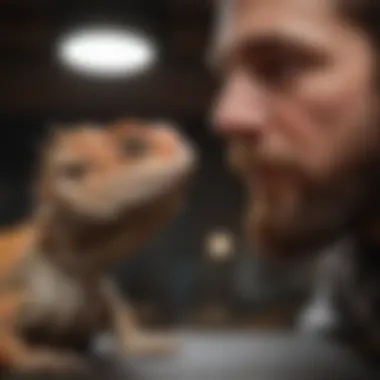
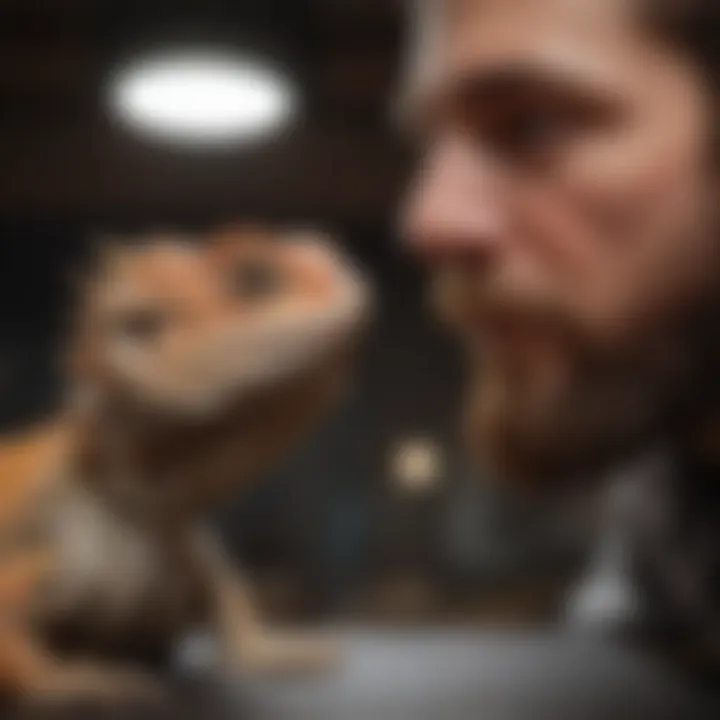
Creating a Stimulating Environment
A stimulating environment fosters a happier bearded dragon. An adequate habitat should have various structures and hides. Climbing branches, rocks, and plants can encourage natural behaviors. This variety simulates their natural habitats, promoting exercise and exploration.
Consider including both warm and cooler places in the enclosure. This allows your bearded dragon to thermoregulate. You can also rotate décor occasionally to prevent boredom. Adding new items will not only enrich their living space but can also present new experiences.
A well-stimulated bearded dragon tends to be healthier and less stressed. Provide an environment that challenges and engages them.
In summary, understanding behavior is essential in keeping a bearded dragon. By focusing on their natural instincts, learning the proper way to handle them, and creating an enriched environment, owners can ensure their pet lives a full and healthy life.
Breeding Considerations
Breeding bearded dragons can be an exciting yet demanding task. It requires a good understanding of the species and an awareness of the challenges involved. Many owners contemplate breeding for various reasons, such as wanting to raise their own pets or even for commercial purposes. However, there are important benefits and considerations to keep in mind before moving forward.
One significant benefit of breeding bearded dragons is the opportunity to contribute to the genetic diversity of the species. This is particularly crucial for maintaining healthy populations. Moreover, breeding can also enhance your bond with these creatures, giving you firsthand experience in their life cycle.
Yet, breeding comes with its own set of challenges. Responsible breeding practices are imperative. Without appropriate knowledge, one may accidentally contribute to issues like overcrowding or poor genetics. Furthermore, it's essential to consider the time commitment involved in caring for both the adults and the hatchlings.
Understanding the Breeding Process
The breeding process of bearded dragons generally involves several key steps. To start, it is crucial to select healthy adult dragons. Sexing can be done by looking at the base of the tail; males have larger hemipenes and a more pronounced shape. Once a male and female are chosen, the pre-breeding condition must be optimal.
Engaging in a cooling period known as "brumation" can trigger the breeding instinct. This cooling phase usually lasts for a few weeks and involves a drop in temperature and light exposure. After this, provide a suitable breeding environment for the pair with enough space.
During the mating process, pairs can mate several times over a few weeks. Females will eventually lay eggs, typically between 15 to 30 eggs, in a secluded area, requiring a designated laying box. Afterwards, the care for the eggs is critical for a successful hatch.
Proper monitoring and maintaining humidity levels in the incubation box are necessary for healthy embryo development.
Caring for Hatchlings
Once the hatchlings emerge, their care becomes the priority. Newborn bearded dragons are extremely delicate and require special attention. First, set up a suitable enclosure with proper basking and cooler areas. Keeping the right temperature is vital to their well-being.
Feeding hatchlings should initially focus on small insects like pinhead crickets or finely chopped vegetables. They have high energy requirements and should be fed multiple times a day. Make sure that the food is appropriately sized to prevent choking.
It is also essential to provide clean water at all times. Monitor their health closely by observing their growth patterns and activity levels.
Integrating Bearded Dragons into Family Life
Integrating a bearded dragon into a family setting involves understanding the dynamics of both the pet and the household. This process is vital for ensuring that both the dragon and family members coexist harmoniously. Bearded dragons are social animals, and their interactions with humans can greatly influence their behavior and adaptation. Addressing this aspect of care not only enhances the well-being of the pet but also educates the family about responsibility and compassion.
Setting Household Rules
Establishing clear household rules regarding the bearded dragon is essential. These rules help to create a safe environment for the reptile and set expectations for family members. Here are some suggested guidelines to consider:
- Designate Caretaker(s): Identify who will be responsible for feeding, cleaning, and monitoring the dragon's health. This helps distribute the responsibility evenly among family members.
- Handling Protocols: Set rules about when and how to handle the bearded dragon. For example, only adults may handle the pet when cleaning the habitat or during health checks, while children may watch and interact under supervision.
- Safe Spaces: Determine areas in the house where the bearded dragon can roam safely. This protects both the dragon from potential hazards and the home from damage.
- Visitors Awareness: Make sure visitors know the presence of the bearded dragon. They should also be informed about how to behave around it to ensure both safety and comfort for everyone.
These household rules can foster a sense of community around the pet. It also prepares everyone for the daily routine that comes with reptile care.
Educating Family Members
Educating family members about bearded dragons is crucial for their successful integration into family life. Understanding the needs and habits of these reptiles can enhance interactions and minimize stress. Here are effective strategies for this:
- Informational Resources: Provide books or articles about bearded dragons. Sources like Wikipedia or Britannica can offer comprehensive information on their care requirements and behavior.
- Hands-On Learning: Encourage family members to observe the bearded dragon during feeding and handling. This practical experience can enlighten them about the pet’s needs and behaviors.
- Discussion Forums: Consider joining online forums like Reddit where family members can connect with other bearded dragon owners. Learning from others' experiences can offer real-life perspectives on care and interaction.
- Educational Videos: Utilize video resources that demonstrate proper care and handling techniques for bearded dragons. Visual learning can be very effective in reinforcing safe practices.
The goal of educating family members is to create a knowledgeable support network for the bearded dragon while promoting a culture of empathy and kindness. This ensures all members are aligned with the care and respect required for a reptile audience.
"Understanding and appreciating the natural behavior of bearded dragons can strengthen the bond between pet and owner, leading to a more fulfilling experience for all."
Integrating a bearded dragon into family life is an ongoing process. Through clear household rules and comprehensive education, families can help their new pet thrive while enriching their own lives in the experience.
Finale
In this article, we explored various vital aspects of bearded dragon care. The conclusion serves to reinforce key insights that can lead to successful ownership. Understanding how to properly care for a bearded dragon is essential for both the pet and the owner. Creating a comfortable habitat, ensuring proper nutrition, and fostering healthy behaviors are significant considerations for anyone taking on the responsibility of this unique pet.
Summary of Key Points
Throughout the guide, we covered the following essential points:
- Species Understanding: Recognizing that bearded dragons are not just exotic pets but also complex creatures with specific needs.
- Habitat Setup: The importance of creating a suitable enclosure, maintaining appropriate temperature and lighting, and choosing the right substrate and décor.
- Nutritional Needs: Understanding that a well-balanced diet, including fresh vegetables and protein sources, is crucial for their health.
- Health Care: Awareness of common health issues and establishing regular veterinary check-ups can help in monitoring their well-being.
- Behavioral Insights: Recognizing natural behaviors and ensuring a stimulating environment contributes to their happiness.
- Breeding Considerations: Knowledge of the breeding process and proper care for hatchlings can prepare owners for possible future responsibilities.
- Family Integration: Setting household rules and educating family members about the pet can improve harmony and understanding.
Final Thoughts on Bearded Dragon Care
Caring for a bearded dragon goes beyond feeding and habitat maintenance. It requires a commitment to ongoing education and adaptation to their evolving needs. Proper socialization and interaction play an important role in their development. By fostering a positive environment, owners can ensure their bearded dragons thrive.
"A well-informed owner leads to a happy bearded dragon."
Ultimately, the knowledge gained from this comprehensive guide can help aspiring bearded dragon owners provide a nurturing home. Engage with communities or forums such as those found on Reddit or specialized groups on Facebook to continue learning and sharing experiences. Each step taken in preparation highlights not just the responsibility adopted, but also the joy these remarkable creatures can bring to our lives.















